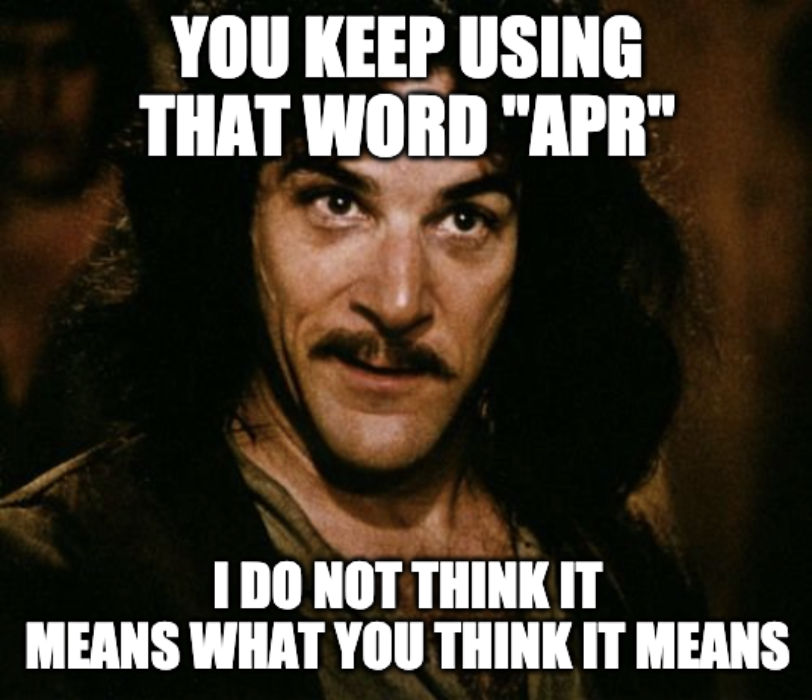
How APR affects your Mortgage Rate
APR is one of the most common industry standards utilized to compare mortgages. It is used by this site as well as every mortgage lender on the planet. While APR is a useful tool, it can be deceiving. In the hands of an unscrupulous loan officer, it can even lead a new home owner into the wrong mortgage product. Don't forget to checkout our APR Calculator once you are done learning about how APR is calculated. So let’s begin!

What is APR
APR stands for “Annual Percentage Rate”. Simple enough right? To understand what is APR, it might be easier to look at the problem it’s trying to solve. Say you have two lenders offering you 30 Year Fixed mortgages for a loan of $200,000. Lender A is offering a 3% mortgage rate with $4,000 in lender fees and $3,000 in third party fees. Lender B is offering the same mortgage at a 3.5% with $0 in lender fees and $3,000 in third party fees. The question to the reader is "which rate is better".
Lender A(Low Rate / High Fees) | Lender B(High Rate / Low Fees) | A vs B | |
|---|---|---|---|
| Loan Amount | $200,000 | $200,000 | $0 |
| Interst Rate | 3.0% | 3.5% | -0.5% |
| Monthly Payment | $843 | $898 | -$55 |
| Third Party Fees | $3,000 | $3,000 | $0 |
| Lender Fees | $4,000 | $0 | +$4,000 |
| Total Closing Cost | $7,000 | $3,000 | + $4,000 |
| APR | 3.281% | 3.622% | -0.341% |
Lender A has a $4,000 higher upfront cost while Lender B has a higher monthly payment ($898 vs $843) that is paid every month for the life of the loan. APR attempts to put these two mortgages on equal footing by adding the upfront costs into the annual interest cost of the mortgage. This is done by a process known as amortization. It just so happens the APR for lenders A and B are 3.281% and 3.622%. Another way we can look at this is that Lender A's upfront fees of $7,000 have added an additional interest cost of 0.281% while Lender B's upfront fees of $3,000 have added an additional 0.122% of interest cost to the loan. Lower APR is better so Lender A is the choice, right? Wrong! Well maybe. Well it depends…. Keep reading.
How is APR Calculated
Well it turns out there are lies, damn lies, and statistics (APR). Numbers need context to be meaningful and APR is no different. To understand APR we need to know a bit more about how it is calculated. In order to put loans on an equal footing, APR assumes that you will stay with the loan for the entire duration of the loan. If you have a 30 Year Fixed mortgage that means 30 years. The chance that a borrower stays in a mortgage for the duration of the loan is very low. Think about your own life? What is the chance you never upgrade homes, pay off your loan early, avoid any new relationships or breaking existing ones (kids, spouses, significant others, etc), stay in the same location, stay with the same company, or refinance because rates are better or your credit score improved? If you are like most people, at least one of those events is likely to occur over the next 30 years, and in fact most lenders know this as well. On average, borrowers remain in the same mortgage for about 5-6 years. Well 5 years is a lot less than 30, so what impact does that have on APR?
Time Effects on APR
Let’s go back briefly to our example of Lender A and Lender B. Lender A offered a 0.5% better rate or $55 less on every monthly payment at the expense of $4,000 in additional costs today. If you stay in the loan for 30 years, that savings of $55/Month * 12 Months * 30 Years will really add up ($19,800 to be exact)! So pay $4,000 today, but get back $19,800 over the next 30 years. Not a bad return! But what if you went to the other extreme?
Stay in Loan for 30 Years... | Lender A(Low Rate / High Fees) | Lender B(Hight Rate / Low Fees) | A vs B |
|---|---|---|---|
| Closing Costs | $7,000 | $3,000 | +$4,000 |
| Total Mortgage Payments | $303,480 | $323,280 | -$19,800 |
| Total | $310,480 | $326,280 | -$15,800 |
Imagine one hour after closing on your beautiful $250,000 home with a $200,000 mortgage, you find out that your great great grand uncle three times removed on your mother’s side has passed away at the gentle age of 107. While saddened at the death of your great great grand uncle you are comforted by the fact that you have been chosen as the sole heir to your uncle’s 20 million dollar estate. With this large windfall, you decide that a $250,000 house while nice, is not nearly as nice as a $2,000,000 house. You decide to change gears and sell the home immediately for the same price you purchased the next day. In this extreme case, you pay $4,000 today to receive a lower rate but receive no benefit of the lower monthly payment leaving you at a $4,000 loss.
Buy and Sellthe Next Day... | Lender A(Low Rate / High Fees) | Lender B(Hight Rate / Low Fees) | A vs B |
|---|---|---|---|
| Closing Costs | $7,000 | $3,000 | +$4,000 |
| Total Mortgage Payments | $0 | $0 | $0 |
| Total | $7,000 | $3,000 | +4,000 |
So time in the loan is the biggest factor to whether you benefit or lose from the lower rate / higher fee mortgage. The time it takes to be indifferent between the two mortgage options is known as a “payback period” or “break-even”. In our case the payback period is $4,000 fees paid today divided by $55 per month in interest savings or (6 years and 22 days). So the answer to “which rate is better” is two fold: Lender B (Higher Rate / Lower Fees) is better if you stay in the loan for less than the payback period while Lender A (Low Rate / Higher Fees) is better if you stay in the loan longer than the payback period.
| Total Cost At | Lender A(Low Rate / High Fees) | Lender B(Hight Rate / Low Fees) | A vs B |
|---|---|---|---|
| 1 Year | $17,116 | $13,776 | +$3,340 |
| 5 Year | $57,580 | $56,880 | +$700 |
| 6 Years 22 days | $68,309 | $68,309 | $0 |
| 15 Years | $158,740 | $164,640 | -$5,900 |
| 30 Years | $310,480 | $326,280 | -$15,800 |
Now you might be asking: "is there a better solution?". Afterall, comparing monthly payments, upfront fees, and payback periods can be complex and time consuming. Luckly, there is a solution - APHog!
APHog - The APR Killer
Now if you have never heard of APHog, you aren’t alone. APHog was developed at MortgageHog to give consumers a realistic way of comparing mortgages. APHog takes away one of the biggest flaws of apr, averaging costs over the entire loan, and instead averages costs over the likely life of the loan. While time in a mortgage loan is different for every person, APHog uses a 5 year estimate for the likely life of the loan. While not perfect, this gives you a much better idea of what the true cost of your loan is. When utilizing the MortgageHog Search Tool, it is recommended to sort rates by lowest APHog to find the most competitive rates.

